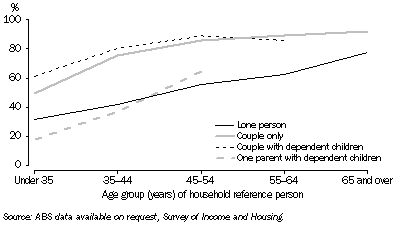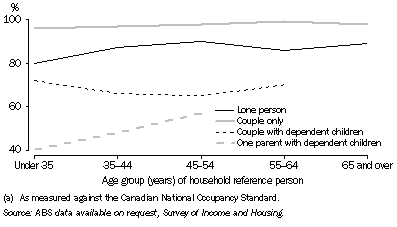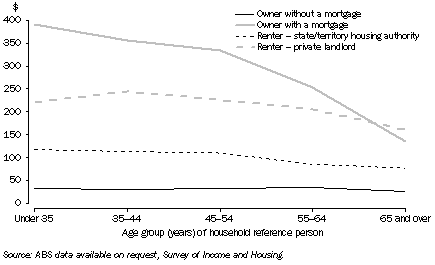HOUSING AND LIFE-CYCLE STAGES
As people progress through different life-cycle stages and their family structures and financial situations change, so do their housing needs and preferences. For young people leaving their parental home, a typical life experience with housing might begin with renting a small flat or unit for themselves or sharing a group house, then moving on to renting an apartment or house with their partner while saving for a deposit on their first home. Many couples will buy their first home and pay off a considerable part of their mortgage before having their first child.
Then, as the number and age of children increase, many will upgrade to a larger house. After the children have left home, most home owners will probably remain in the same home at least until retirement, by which time most will own their home outright. After retirement, some will change location, and in doing so a few will choose a smaller home, possibly a unit in a retirement village. Later, some who are too old or frail to live in their own home will move into cared accommodation (see Aged care in the Income and welfare chapter).
While most Australians aspire to own their home outright, at least by the time they retire, many on low incomes cannot afford to buy a home and some cannot afford to rent adequate housing. There are a range of government programs aimed at assisting low income households to buy or rent suitable and affordable housing (see Housing assistance).
In 2005-06, almost half of young (reference person aged under 35 years) couple-only households, and over half of young couples with dependent children owned their home (49% and 61% respectively) (graph 10.20 and table 10.22). The home ownership rate was considerably lower for young lone-person households (32%).
Home ownership rates increased with age of reference person up to aged 45-54 years for all family and household groups. Beyond this age, the home ownership rate for couple-only households continued to increase as the rate for couples with dependents declined, reflecting the transition of couple families with children to 'empty nest' couple-only households. Similarly, at age 65 years and over, home ownership rates for lone-person and couple-only households had converged to some extent, reflecting the transition of couple-only households to lone-person households following the death of one partner.
One-parent families with dependent children had the lowest home ownership rate (40%) and the highest proportion of renters, particularly public renters. In 2005-06, 15% of all one-parent families with dependent children were renting from a state/territory housing authority and 40% were renting privately. Lone-person households also had relatively high proportions of renters, with 7% renting from a state/territory housing authority and 27% renting privately.
10.20 Home ownership rates, by household composition
- 2005-06

People living alone are more likely to live in high density housing than any other group, particularly when young. In 2005-06, the proportion of lone persons living in a flat, unit or apartment ranged from 35% of those aged under 35 years to 13% of those aged 65 years and over. Even so, lone persons were more likely to have one or more spare bedrooms than families with children. In 2005-06, 87% of lone-person households and 98% of couple-only households had one or more spare bedrooms (graph 10.21).
10.21 Households with one or more spare bedrooms(a) - 2005-06

10.22 SELECTED HOUSEHOLD AND DWELLING CHARACTERISTICS(a) - 2005-06 |
|  |
 |  |  |  | Proportion of households with characteristic |  |
 | Estimated number of households | Average number of persons in household | Average number of bedrooms in dwelling | One or more spare bedrooms(b) | Living in separate house | Living in flat/unit/ apartment | Home owner | Renter |  |
| Household composition | '000 | no. | no. | % | % | % | % | % |  |
REFERENCE PERSON AGED UNDER 35 YEARS |  |
|  |
| Lone person | 369.3 | 1.0 | 2.3 | 80.5 | 47.4 | 35.0 | 31.7 | 60.7 |  |
| Couple only | 423.5 | 2.0 | 2.7 | 96.2 | 64.9 | 20.3 | 49.0 | 49.6 |  |
| Couple family with dependent children | 462.9 | 3.8 | 3.2 | 72.1 | 84.5 | 7.5 | 61.3 | 36.0 |  |
| One parent family with dependent children | 168.0 | 3.1 | 2.9 | 40.2 | 74.4 | *10.3 | 17.3 | 81.7 |  |
| All households(c) | 1 765.2 | 2.5 | 2.8 | 71.9 | 67.7 | 19.1 | 42.1 | 54.6 |  |
REFERENCE PERSON AGED 35-44 YEARS |  |
|  |
| Lone person | 268.9 | 1.0 | 2.5 | 87.3 | 59.0 | 23.5 | 41.8 | 53.9 |  |
| Couple only | 176.6 | 2.0 | 3.0 | 97.0 | 77.1 | 11.1 | 75.1 | 24.6 |  |
| Couple family with dependent children | 909.8 | 4.3 | 3.5 | 65.7 | 91.4 | 3.1 | 80.4 | 18.0 |  |
| One parent family with dependent children | 208.1 | 3.0 | 3.1 | 48.5 | 74.9 | 8.8 | 36.9 | 61.1 |  |
| All households(c) | 1 703.8 | 3.3 | 3.2 | 69.8 | 81.5 | 8.5 | 66.1 | 32.0 |  |
REFERENCE PERSON AGED 45-54 YEARS |  |
|  |
| Lone person | 303.5 | 1.0 | 2.5 | 90.0 | 66.0 | 19.0 | 55.4 | 41.9 |  |
| Couple only | 258.1 | 2.0 | 3.3 | 97.8 | 89.6 | *3.9 | 86.1 | 12.8 |  |
| Couple family with dependent children | 602.8 | 4.2 | 3.7 | 64.7 | 92.8 | 3.1 | 88.9 | 10.3 |  |
| One parent family with dependent children | 134.8 | 3.0 | 3.3 | 57.0 | 90.6 | *4.6 | 64.4 | 33.1 |  |
| All households(c) | 1 607.7 | 2.9 | 3.3 | 74.9 | 85.8 | 6.7 | 77.9 | 20.6 |  |
REFERENCE PERSON AGED 55-64 YEARS |  |
|  |
| Lone person | 347.3 | 1.0 | 2.5 | 85.7 | 60.0 | 21.7 | 62.2 | 34.3 |  |
| Couple only | 506.8 | 2.0 | 3.2 | 98.9 | 88.7 | 3.4 | 89.3 | 9.7 |  |
| Couple family with dependent children | 93.2 | 3.9 | 3.9 | 70.3 | 93.0 | **3.2 | 85.8 | *13.5 |  |
| All households(c) | 1 261.3 | 2.1 | 3.1 | 87.5 | 81.4 | 8.7 | 81.2 | 17.3 |  |
REFERENCE PERSON AGED 65 AND OVER |  |
|  |
| Lone person | 744.3 | 1.0 | 2.6 | 88.9 | 71.1 | 13.4 | 77.5 | 18.9 |  |
| Couple only | 678.8 | 2.0 | 3.0 | 97.5 | 87.8 | 4.9 | 92.3 | 5.9 |  |
| All households(c) | 1 588.1 | 1.6 | 2.8 | 91.3 | 80.3 | 8.7 | 84.6 | 12.8 |  |
ALL AGE GROUPS |  |
|  |
| Lone person | 2 033.3 | 1.0 | 2.5 | 86.8 | 62.5 | 20.9 | 58.5 | 37.2 |  |
| Couple only | 2 043.8 | 2.0 | 3.0 | 97.6 | 82.6 | 8.1 | 80.3 | 18.4 |  |
| Couple family with dependent children | 2 078.6 | 4.1 | 3.5 | 67.0 | 90.3 | 4.1 | 78.8 | 19.7 |  |
| One parent family with dependent children | 538.6 | 3.0 | 3.1 | 47.9 | 78.9 | 8.4 | 39.8 | 58.5 |  |
| All households(c) | 7 926.2 | 2.5 | 3.1 | 78.4 | 79.0 | 10.6 | 69.3 | 28.5 |  |
|  |
| * estimate has a relative standard error of 25% to 50% and should be used with caution |
| ** estimate has a relative standard error greater than 50% and is considered too unreliable for general use |
| (a) By age group of household reference person. |
| (b) As measured against the Canadian National Occupancy Standard. |
| (c) Includes all other family and household types. |
| Source: ABS data available on request, Survey of Income and Housing. |
There are long-term benefits in home ownership. Initially, the cost of home purchase is often far greater than renting (due to the costs of deposits and fees, as well as ongoing mortgage repayments). However, the much lower costs associated with owning a home outright, and the investment that a home represents, can be major contributors to economic wellbeing, particularly for older people, as many retire on considerably reduced incomes.
In 2005-06, the average weekly housing costs of young households with a mortgage was $391 - 76% more than the average weekly rent of young private renters (graph 10.23). The difference in housing costs between owners with a mortgage and private renters was progressively smaller in older age groups, mainly because of progressively lower mortgage payments. For households with a reference person aged 65 years and over, private rents were higher, on average, than the housing costs of home owners with a mortgage.
10.23 Average weekly housing costs, by tenure
- 2005-06

The difference in housing costs between younger and older owners with a mortgage is largely a reflection of the difference in house prices, and hence the amount borrowed, at the time of purchase. On average, recent home buyers paid higher prices than those who bought their homes ten or more years ago. In 2005-06, more than half (54%) of young households with a mortgage were recent home buyers compared with 14% of the oldest home owners (reference person aged 65 years and over) with a mortgage (table 10.24). The average mortgage outstanding for young home owners was $190,000 compared with $95,000 for the oldest.
For other tenure types, there was much less variation in housing costs across age groups (graph 10.23). In 2005-06, average weekly rents rose from $221 for young households renting privately to $244 for those with a reference person aged 35-44 years, and were progressively lower for older private renters. This pattern largely reflects the need for larger households to rent larger, and often more expensive, dwellings. In 2005-06, couple families with dependent children represented 22% of young private renter households; 35% of those with a reference person aged 35-44 years; and 26% of those with a reference person aged 45-54 years.
Average weekly rents of public renters were less than half those of private renters, starting at $117 for younger households and declining to $77 for the oldest. Owners without a mortgage had by far the lowest and least variable housing costs, averaging $29 per week overall.
10.24 HOUSING COSTS, MORTGAGE, AND TENURE AND LANDLORD TYPE(a) - 2005-06 |
|  |
 |  |  |  |  | Proportion of households with characteristic |  |
 | Average weekly housing costs | Average housing costs as a proportion of gross household income(b) | Average amount of mortgage outstanding(c) | Proportion of owners with a mortgage who are recent home buyers(d) | Owner without a mortgage | Owner with a mortgage | Renter - state/territory housing authority | Renter - private landlord |  |
| Household composition | $ | % | $'000 | % | % | % | % | % |  |
REFERENCE PERSON AGED UNDER 35 YEARS |  |
|  |
| Lone person | 211 | 25 | 165 | 63.8 | *3.5 | 28.3 | *4.1 | 51.9 |  |
| Couple only | 314 | 19 | 207 | 69.2 | 2.7 | 46.3 | *1 | 45.9 |  |
| Couple family with dependent children | 300 | 20 | 195 | 42.6 | 5.1 | 56.2 | 2.9 | 30.3 |  |
One parent family with
dependent children | 181 | 25 | 142 | *44.8 | *4.1 | 13.2 | 17.4 | 60.5 |  |
| All households(e) | 259 | 19 | 190 | 53.9 | 5.7 | 36.4 | 4.3 | 47.3 |  |
REFERENCE PERSON AGED 35-44 YEARS |  |
|  |
| Lone person | 190 | 21 | 123 | 26.8 | 9.7 | 32.1 | *4.6 | 47.3 |  |
| Couple only | 308 | 16 | 183 | 38.2 | 14.0 | 61.1 | **0.9 | 22.7 |  |
| Couple family with dependent children | 308 | 17 | 177 | 27.1 | 12.4 | 68.0 | 2.0 | 15.0 |  |
| One parent family with dependent children | 177 | 22 | 116 | 27.5 | 9.4 | 27.5 | 16.9 | 40.7 |  |
| All households(e) | 266 | 17 | 168 | 28.3 | 12.4 | 53.8 | 4.8 | 25.6 |  |
REFERENCE PERSON AGED 45-54 YEARS |  |
|  |
| Lone person | 143 | 16 | 106 | 22.2 | 24.1 | 31.3 | 8.7 | 31.4 |  |
| Couple only | 205 | 13 | 125 | 26.4 | 37.5 | 48.6 | **2.1 | 9.4 |  |
| Couple family with dependent children | 276 | 12 | 165 | 20.6 | 27.6 | 61.3 | *1.2 | 8.5 |  |
| One parent family with dependent children | 180 | 15 | 115 | 22.0 | 22.3 | 42.2 | 10.0 | 18.6 |  |
| All households(e) | 213 | 12 | 140 | 21.4 | 29.3 | 48.6 | 4.2 | 14.9 |  |
REFERENCE PERSON AGED 55-64 YEARS |  |
|  |
| Lone person | 91 | 15 | 95 | *17.4 | 45.1 | 17.1 | 11.8 | 20.5 |  |
| Couple only | 100 | 8 | 98 | 16.8 | 61.1 | 28.2 | *1.9 | 6.5 |  |
| Couple family with dependent children | 217 | 9 | 140 | **8.2 | 50.3 | 35.5 | **2.2 | *10.4 |  |
| All households(e) | 117 | 9 | 103 | 14.6 | 53.7 | 27.5 | 4.9 | 11.0 |  |
REFERENCE PERSON AGED 65 AND OVER |  |
|  |
| Lone person | 39 | 10 | 37 | **8.3 | 74.0 | 3.5 | 7.8 | 8.5 |  |
| Couple only | 41 | 5 | 135 | *16.3 | 86.4 | 5.9 | *2.1 | 3.3 |  |
| All households(e) | 42 | 7 | 95 | **14.0 | 79.3 | 5.3 | 5.1 | 6.1 |  |
ALL AGE GROUPS |  |
|  |
| Lone person | 115 | 17 | 120 | 33.2 | 40.3 | 18.2 | 7.5 | 27.0 |  |
| Couple only | 156 | 12 | 156 | 39.3 | 50.3 | 30.0 | 1.7 | 15.4 |  |
| Couple family with dependent children | 292 | 15 | 176 | 27.8 | 17.0 | 61.8 | 2.0 | 16.3 |  |
| One parent family with dependent children | 177 | 20 | 117 | 26.2 | 12.8 | 27.0 | 14.8 | 40.1 |  |
| All households(e) | 185 | 14 | 155 | 30.1 | 34.3 | 35.0 | 4.7 | 22.0 |  |
|  |
| * estimate has a relative standard error of 25% to 50% and should be used with caution |
| ** estimate has a relative standard error greater than 50% and is considered too unreliable for general use |
| (a) By age group of household reference person. |
| (b) Excludes households with nil or negative total income. |
| (c) Only Includes owners with a mortgage. |
| (d) Owners who built or purchased their dwelling in the three years prior to the survey. |
| (e) Includes all other family and household types. |
| Source: ABS data available on request, Survey of Income and Housing. |
Much of the variation in housing costs between households at different life-cycle stages is related to differences in tenure patterns. For example, in 2005-06, households with a reference person aged 35-44 years had the highest average weekly housing costs ($266). They also had the highest proportion of owners with a mortgage (54%), the second highest proportion of recent home buyers (28% of all home owners with a mortgage), the second highest average amount of mortgage outstanding ($168,000) and the second highest proportion of private renters (26%).
Housing costs were on average lower for younger (reference person aged under 35 years) households ($259 per week). Even though this group had the highest proportion of recent home buyers (54%), only 36% of younger households were owners with a mortgage. Those who were owners with a mortgage had the highest average amount of mortgage outstanding ($190,000). This group also had the highest proportion of private renters (47%) and the lowest proportion of owners without a mortgage (6%).
At the other end of the age spectrum, the oldest households (with a reference person aged 65 years and over) had the highest proportion of home owners without a mortgage (79%), the lowest proportion of private renters (6%), the highest proportion of public renters (5%), and, for those in this group that had a mortgage, it was the lowest of all age groups ($95,000). Together these factors resulted in this group having by far the lowest average housing costs ($42 per week).
Housing costs decline with age for all family and household types, as does the proportion of household income spent on housing, but to a lesser extent. For example, in 2005-06, the oldest lone-person households paid an average of $39 (10% of their gross household income) for housing, while the youngest lone-person households paid $211 (25% of their gross household income) for housing.
 Print Page
Print Page